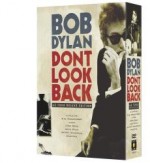
This country is in a state of reflection and deep repair. We are in the throws of the worst economic crisis in a long while; we are coming off the coattails of George W. Bush, and we are moving into a new and exciting time in which artistic expression is finding a stronger, more powerful voice through the various new art forms that are being developed everyday.
I say all this because there are parallels between the present day and the sixties, when Bob Dylan was making his unique mark on the world of popular music and poetry. He was the man that people looked to be a voice of reason in times of uncertainty and confusion. Of course, he wasn’t really looking to be that voice for most people; he just considered himself to be a man writing songs because he wanted to write songs.
D.A. Pennebaker’s 1967 documentary “Don’t Look Back” follows Dylan on tour in England, his last acoustic tour before he went electric, a move that many of his fans would never forgive him for. Through out the gritty black and white documentary, we get a very intimate look at the artist in his younger years. At times, Pennebaker’s film isn’t very flattering, but it is always honest.
Many critics of this film are quick to point out that Dylan comes off as a self-absorbed jerk who treats the people around him as if they were lucky to be in his presence. While that critique is rather fair, I think there is more to Dylan’s behavior than meets the eye. Dylan has been notorious for changing his entire persona throughout his career, often changing his personality to match the style of the music on whichever album he was recording at the time. In this phase of his career, Dylan was getting extremely tired of being constantly asked by the press about what his songs were suppose to mean. He never liked to explain his style to anyone, or explain where his songs came from. According to him, they just happened. It should come as no surprise then that Dylan became a bit of a jerk during this time in his life; anyone would get annoyed with having to constantly explain what their work is suppose to be saying. That being said, there are some moments of the film where one has to suspect that Dylan is letting his recent fame go to his head.
In a rather sad but revealing scene, we see Dylan waiting in his dressing room before a show, playing music with Alan Price, the former piano player for The Animals. Price had just recently been kicked out of the band and was clearly trying his hardest to have a good time and forget how depressed he was about not being in the band anymore. Both he and Dylan are having a good time, playing music and joking around, when Dylan asks about The Animals new piano player, Price’s replacement. After that Price becomes visibly saddened and gets very quiet until he starts playing a blues song on the piano and singing in a very sad tone, before giving up entirely and opening a bottle of beer. This scene is important because it shows how badly someone in the spotlight can hurt someone who used to be there with just a few words.
To just dwell on the negative aspects of the film would take away from the fact that it is one of the best documentaries that has ever been made on the subject of a rock star. We get a true fly on the wall perspective of Dylan, courtesy of director and camera man Pennebaker. He followed Dylan around for months on this tour, getting some of the most invaluable, candid footage of him that anyone would see for years to come. Not to mention, the DVD of the film comes in one of the best double disc packages that I have had the pleasure of purchasing in a long time. It has many extras, such as a commentary from Pennebaker and Dylan’s road manager, Bob Neuwirth, a book of transcriptions of all the scenes in the film, and a second disc that has over an hour’s worth of deleted scenes and performances with commentary.
I can’t recommend this movie enough, and I would like to also recommend seeing Martin Scorsese’s documentary “No Direction Home,” which makes an excellent companion piece to Pennebaker’s documentary. By watching both, you can get what some people would consider the most complete history of Bob Dylan’s acoustic and electric years.
Be sure to put “Don’t Look Back” at the top of your queue on Netflix, and enjoy it when it shows up in the mail.






